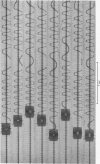Full text
PDF













Images in this article
Selected References
These references are in PubMed. This may not be the complete list of references from this article.
- Adrian E. D., Zotterman Y. The impulses produced by sensory nerve endings: Part 3. Impulses set up by Touch and Pressure. J Physiol. 1926 Aug 6;61(4):465–483. doi: 10.1113/jphysiol.1926.sp002308. [DOI] [PMC free article] [PubMed] [Google Scholar]
- DAVIS H., TASAKI I., GOLDSTEIN R. The peripheral origin of activity, with reference to the ear. Cold Spring Harb Symp Quant Biol. 1952;17:143–154. doi: 10.1101/sqb.1952.017.01.014. [DOI] [PubMed] [Google Scholar]
- EDWARDS C. The effect of electric polarization of sensory nerve endings on the discharge from a muscle spindle. J Physiol. 1954 May 28;124(2):2P–2P. [PubMed] [Google Scholar]
- GRAY J. A., SATO M. Properties of the receptor potential in Pacinian corpuscles. J Physiol. 1953 Dec 29;122(3):610–636. doi: 10.1113/jphysiol.1953.sp005025. [DOI] [PMC free article] [PubMed] [Google Scholar]
- GROEN J. J., LOWENSTEIN O., VENDRIK J. H. The mechanical analysis of the responses from the end-organs of the horizontal semicircular canal in the isolated elasmobranch labyrinth. J Physiol. 1952 Jul;117(3):329–346. doi: 10.1113/jphysiol.1952.sp004752. [DOI] [PMC free article] [PubMed] [Google Scholar]
- HALLPIKE C. S., HOOD J. D. Fatigue and adaptation of the cupular mechanism of the human horizontal semicircular canal: an experimental investigation. Proc R Soc Lond B Biol Sci. 1953 Sep;141(905):542–561. doi: 10.1098/rspb.1953.0060. [DOI] [PubMed] [Google Scholar]
- Hodgkin A. L. The local electric changes associated with repetitive action in a non-medullated axon. J Physiol. 1948 Mar 15;107(2):165–181. doi: 10.1113/jphysiol.1948.sp004260. [DOI] [PMC free article] [PubMed] [Google Scholar]
- JIELOF R., SPOOR A., DE VRIES H. The microphonic activity of the lateral line. J Physiol. 1952 Feb;116(2):137–157. doi: 10.1113/jphysiol.1952.sp004695. [DOI] [PMC free article] [PubMed] [Google Scholar]
- KATSUKI Y., YOSHINO S. Response of the single lateral-line nerve fiber to the linearly rising current stimulating the endorgan. Jpn J Physiol. 1952 Feb;2(3):219–231. doi: 10.2170/jjphysiol.2.219. [DOI] [PubMed] [Google Scholar]
- KATZ B. Action potentials from a sensory nerve ending. J Physiol. 1950 Oct 16;111(3-4):248–260. doi: 10.1113/jphysiol.1950.sp004478. [DOI] [PMC free article] [PubMed] [Google Scholar]
- Katz B. Multiple response to constant current in frog's medullated nerve. J Physiol. 1936 Nov 6;88(2):239–255. doi: 10.1113/jphysiol.1936.sp003435. [DOI] [PMC free article] [PubMed] [Google Scholar]
- LOWENSTEIN O., ROBERTS T. D. M. The equilibrium function of the otolith organs of the thornback ray (Raja clavata). J Physiol. 1949 Dec;110(3-4):392–415. doi: 10.1113/jphysiol.1949.sp004448. [DOI] [PMC free article] [PubMed] [Google Scholar]
- Löwenstein O., Sand A. The individual and integrated activity of the semicircular canals of the elasmobranch labyrinth. J Physiol. 1940 Dec 20;99(1):89–101. doi: 10.1113/jphysiol.1940.sp003881. [DOI] [PMC free article] [PubMed] [Google Scholar]
- Matthews B. H. The response of a single end organ. J Physiol. 1931 Jan 21;71(1):64–110. doi: 10.1113/jphysiol.1931.sp002718. [DOI] [PMC free article] [PubMed] [Google Scholar]



